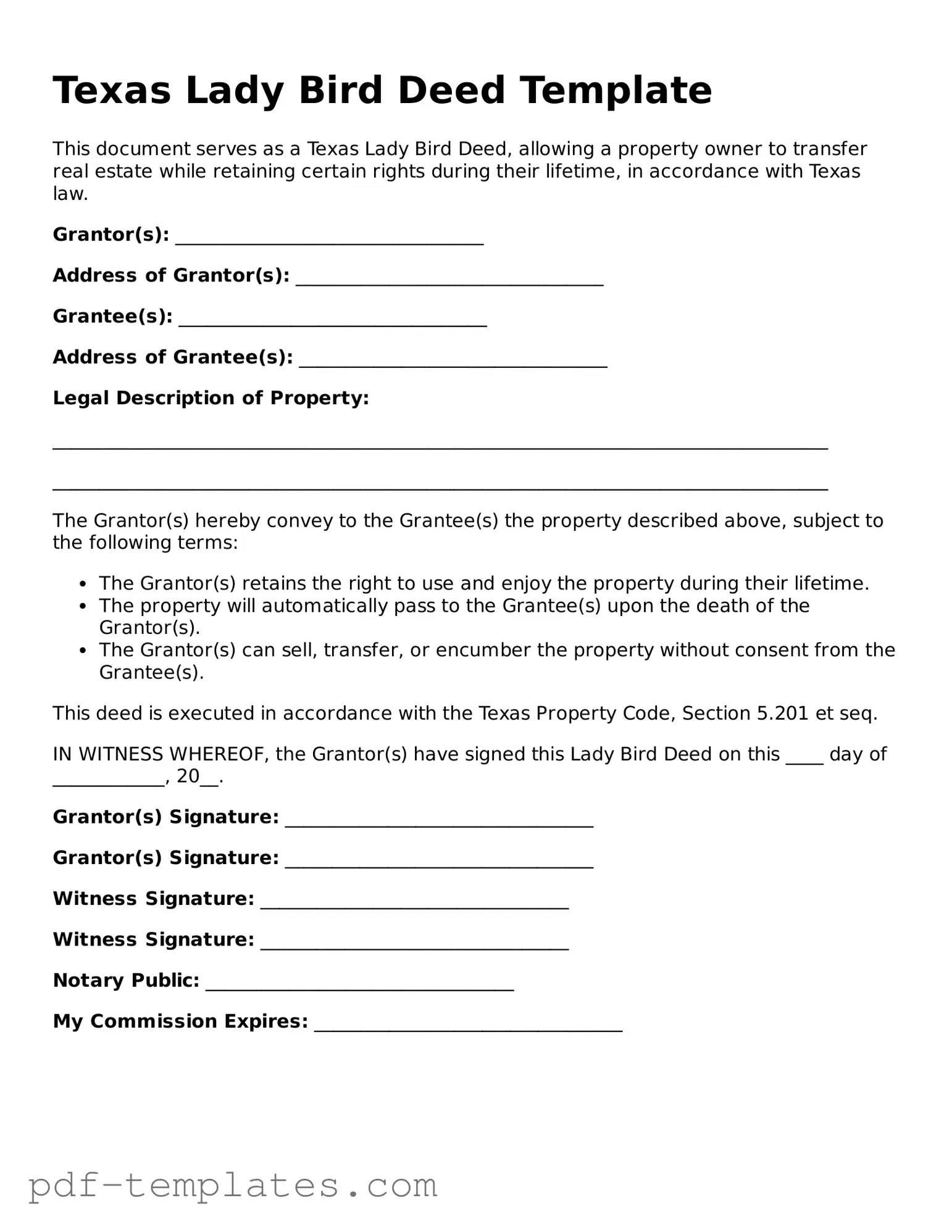The Texas Lady Bird Deed is similar to a traditional warranty deed. Both documents serve to transfer property ownership from one party to another. However, a warranty deed provides a guarantee that the property is free of any encumbrances, while a Lady Bird Deed allows the original owner to retain certain rights, such as the right to live on the property and the ability to sell or mortgage it without the consent of the beneficiary.
Another document comparable to the Lady Bird Deed is the quitclaim deed. A quitclaim deed transfers any interest the grantor may have in the property without making any guarantees about the title. Unlike the Lady Bird Deed, which can provide a smooth transition of property upon death while retaining rights during the owner’s lifetime, a quitclaim deed offers no protection or assurances to the grantee regarding the property’s condition or title.
The life estate deed is also similar in nature. This document allows a property owner to retain the right to use and occupy the property during their lifetime, while transferring the remainder interest to another party. Like the Lady Bird Deed, a life estate deed ensures that the owner can live on the property until death, but it does not offer the same flexibility to sell or encumber the property without the consent of the remainderman.
A transfer-on-death deed is another relevant document. This deed allows the property owner to designate a beneficiary who will automatically receive the property upon the owner’s death, bypassing probate. Similar to the Lady Bird Deed, it provides a way to transfer property outside of probate, but it does not allow the original owner to retain any rights to the property during their lifetime.
Understanding the nuances of property transfer methods is essential for homeowners. For instance, complexities arise with various deeds, such as the Lady Bird Deed, which provides unique benefits compared to others like the quitclaim or warranty deed. Notably, property owners in California may also need to consider the All California Forms when dealing with liens that could affect their property rights and payment claims in the construction industry.
The revocable living trust is another document that shares similarities with the Lady Bird Deed. Both instruments facilitate the transfer of property upon death while allowing the original owner to maintain control during their lifetime. However, a revocable living trust involves a more complex legal structure and requires the property to be formally transferred into the trust, whereas a Lady Bird Deed is simpler and directly recorded with the county.
Another comparable document is the enhanced life estate deed. This deed allows the property owner to retain a life estate while also designating a beneficiary to receive the property after death. Like the Lady Bird Deed, it offers the advantage of avoiding probate. However, the enhanced life estate deed may not provide the same level of control over the property during the owner’s lifetime.
The special warranty deed is similar in that it transfers ownership of property, but it only guarantees the title against claims that arose during the time the grantor owned the property. Unlike the Lady Bird Deed, which allows for continued control and use, a special warranty deed does not provide ongoing rights to the grantor after the transfer.
The beneficiary deed, similar to the Lady Bird Deed, allows property to be transferred upon the owner’s death without going through probate. However, unlike the Lady Bird Deed, the beneficiary deed does not allow the owner to retain rights to the property during their lifetime, making it less flexible in terms of property management.
The joint tenancy deed is another document that relates to property ownership. This deed allows two or more individuals to own property together with rights of survivorship. While it facilitates the transfer of property upon the death of one owner, it does not provide the same level of control as a Lady Bird Deed, where the original owner can still manage the property during their lifetime.
Finally, the community property agreement is relevant in the context of property ownership between spouses. This agreement allows spouses to agree on how to handle property ownership and transfer upon death. While it can simplify the transfer process, it does not offer the same individual control over property as the Lady Bird Deed, which allows one owner to dictate the terms of transfer without requiring consent from a spouse.
